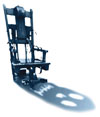Friday, July 14, 2006
Constitutional?
 It seems that an inmate in Virginia is choosing to die by the electric chair rather than by lethal injection, according to a number of news outlets (read the text of the standard story here). This would be the first execution by electrocution in two years. Many states have ended the use of the electric chair, but others like Virginia, and of course Tennessee, still have the option available.
It seems that an inmate in Virginia is choosing to die by the electric chair rather than by lethal injection, according to a number of news outlets (read the text of the standard story here). This would be the first execution by electrocution in two years. Many states have ended the use of the electric chair, but others like Virginia, and of course Tennessee, still have the option available.Recently, doing a debate show with a death penalty supporter regarding the Supreme Court's decision to allow inmates to proceed with challenges to the constitutionality of lethal injection procedures, the death penalty supporter drew a stark line between humane methods, like lethal injection which they supported, and more brutal ones, like electrocution. For once, on a small point, at least, we were in agreement.
Consider just a few of the electrocutions that have gone horrendously wrong in the so-called modern era:
May 4, 1990. Florida. Jesse Joseph Tafero. Electrocution. During the execution, six-inch flames erupted from Tafero's head, and three jolts of power were required to stop his breathing. State officials claimed that the botched execution was caused by "inadvertent human error" -- the inappropriate substitution of a synthetic sponge for a natural sponge that had been used in previous executions. They attempted to support this theory by sticking a part of a synthetic sponge into a "common household toaster" and observing that it smoldered and caught fire.
Or again:
July 8, 1999. Florida. Allen Lee Davis. "Before he was pronounced dead ... the blood from his mouth had poured onto the collar of his white shirt, and the blood on his chest had spread to about the size of a dinner plate, even oozing through the buckle holes on the leather chest strap holding him to the chair."45 His execution was the first in Florida's new electric chair, built especially so it could accommodate a man Davis's size (approximately 350 pounds). Later, when another Florida death row inmate challenged the constitutionality of the electric chair, Florida Supreme Court Justice Leander Shaw commented that "the color photos of Davis depict a man who -- for all appearances -- was brutally tortured to death by the citizens of Florida."46 Justice Shaw also described the botched executions of Jesse Tafero and Pedro Medina (q.v.), calling the three executions "barbaric spectacles" and "acts more befitting a violent murderer than a civilized state."47 Justice Shaw included pictures of Davis's dead body in his opinion.

The death penalty is certainly cruel and it is certainly unjust. But using methods that can produce such heinous and horrific results should give pause even to the staunchest of death penalty supporters. And we still have the electric chair sitting waiting in Tennessee's death chamber.
*The above descriptions of the executions were taken from the Death Penalty Information Center.


